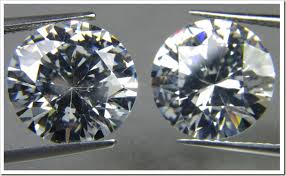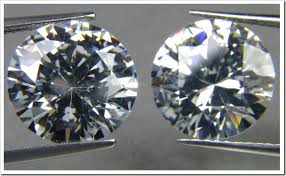
A diamond can be grown in days in a laboratory while one in nature takes billions of years to produce.
For De Beers, the holder of a roughly 30 percent share of the market for genuine rough diamonds, protecting its reputation as the world's leading diamond firm by value is fundamentally dependent on telling the difference between a natural and laboratory made diamond. It makes money from selling its detection equipment, authenticates diamonds for third parties and guarantees all its own mined diamonds are natural.
The means to determine whether a stone was created in the earth's mantle or is man-made has industry wide demands and is driven by increasingly sophisticated technology to produce synthetic diamonds.
And emotion is not the only reason for this differentiation. Synthetic diamonds have no investment value and sell for an estimated 30 percent less than the real thing. It would be a fraud if an unscrupulous retailer passes off the man-made as natural.
"For the diamond business, the one thing you don't want is for consumers to lose trust," Jonathan Kendall, president of De Beers' International Institute of Diamond Grading and Research, said.
Whether a diamond is natural or synthetic can be determined with 100 percent accuracy by staff at a De Beers laboratory in leafy Maidenhead, west of London, far from the diamond-rich kimberlite rock of South Africa.
While all the rough diamonds De Beers sells for jewelry are real, the company itself has a unit that makes synthetic diamonds, but only for industrial usages, such as drilling and cutting.
Ever since De Beers has been placed at the core of a slimmed down portfolio, with a view to strengthening the balance sheet following a commodities rout by its indebted parent Anglo American, the pressure on De Beers to be the industry standard has increased.
Analysts say that compared with approximately 130 million carats of rough diamonds mined annually, approximately 300,000 carats of synthetic diamonds are produced a year.
They further claim that while natural production is expected to stagnate, technological advances will produce more synthetic diamonds and of better quality.
De Beers has sold tens of millions of pounds worth of equipment to detect synthetic diamonds to other diamond traders and jewelers eve since it took back a distribution license in late 2012 from the Gemological Institute of America, the world's biggest diamond grading laboratory, Kendall says.
The place of carbon, from which diamonds are made, in the periodic table is the source of the name that was given to De Beers' synthetic diamond unit Element Six, the world's leading supplier of synthetic industrial diamonds.
De Beers says demand is affected by factors such as a slow-down in drilling because of cheaper oil even as it does not break out Element Six's results. In the first half of the year, when Anglo American made a loss, De Beers managed a profit as a whole.
As Element Six strives to produce synthetic diamonds that are indistinguishable from real - so far an unattainable goal, poacher versus game keeper, or cat and mouse is the description that the 80 scientific and technical staff at the Maidenhead laboratory describes their relationship with Element Six as.
(Source:www.reuters.com)
For De Beers, the holder of a roughly 30 percent share of the market for genuine rough diamonds, protecting its reputation as the world's leading diamond firm by value is fundamentally dependent on telling the difference between a natural and laboratory made diamond. It makes money from selling its detection equipment, authenticates diamonds for third parties and guarantees all its own mined diamonds are natural.
The means to determine whether a stone was created in the earth's mantle or is man-made has industry wide demands and is driven by increasingly sophisticated technology to produce synthetic diamonds.
And emotion is not the only reason for this differentiation. Synthetic diamonds have no investment value and sell for an estimated 30 percent less than the real thing. It would be a fraud if an unscrupulous retailer passes off the man-made as natural.
"For the diamond business, the one thing you don't want is for consumers to lose trust," Jonathan Kendall, president of De Beers' International Institute of Diamond Grading and Research, said.
Whether a diamond is natural or synthetic can be determined with 100 percent accuracy by staff at a De Beers laboratory in leafy Maidenhead, west of London, far from the diamond-rich kimberlite rock of South Africa.
While all the rough diamonds De Beers sells for jewelry are real, the company itself has a unit that makes synthetic diamonds, but only for industrial usages, such as drilling and cutting.
Ever since De Beers has been placed at the core of a slimmed down portfolio, with a view to strengthening the balance sheet following a commodities rout by its indebted parent Anglo American, the pressure on De Beers to be the industry standard has increased.
Analysts say that compared with approximately 130 million carats of rough diamonds mined annually, approximately 300,000 carats of synthetic diamonds are produced a year.
They further claim that while natural production is expected to stagnate, technological advances will produce more synthetic diamonds and of better quality.
De Beers has sold tens of millions of pounds worth of equipment to detect synthetic diamonds to other diamond traders and jewelers eve since it took back a distribution license in late 2012 from the Gemological Institute of America, the world's biggest diamond grading laboratory, Kendall says.
The place of carbon, from which diamonds are made, in the periodic table is the source of the name that was given to De Beers' synthetic diamond unit Element Six, the world's leading supplier of synthetic industrial diamonds.
De Beers says demand is affected by factors such as a slow-down in drilling because of cheaper oil even as it does not break out Element Six's results. In the first half of the year, when Anglo American made a loss, De Beers managed a profit as a whole.
As Element Six strives to produce synthetic diamonds that are indistinguishable from real - so far an unattainable goal, poacher versus game keeper, or cat and mouse is the description that the 80 scientific and technical staff at the Maidenhead laboratory describes their relationship with Element Six as.
(Source:www.reuters.com)





